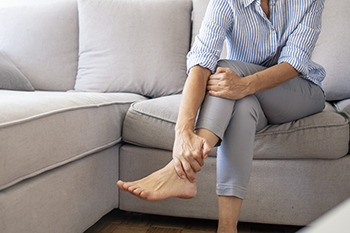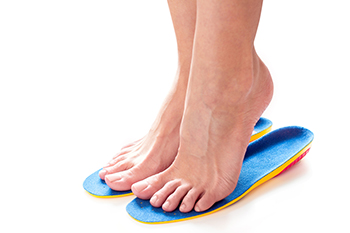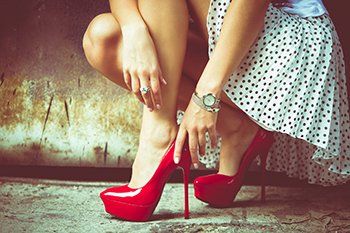Items filtered by date: October 2023
The Discomfort of Arthritis in the Feet

Arthritis, a debilitating condition affecting millions of people across the globe, often makes its presence felt most acutely in the feet. For those who suffer from foot arthritis, every step can be a reminder of the persistent discomfort and pain they endure. The sensation is similar to walking on a bed of nails, or with each step, having sharp, stabbing sensations coursing through the soles. Arthritis does not discriminate, and it can affect any joint in the foot, from the toes to the ankle. Morning stiffness and joint swelling are common symptoms for those with foot arthritis, making the mere act of getting out of bed an ordeal. Activities that once brought joy, such as walking, running, or even standing, can become agonizing challenges. It is not just physical; foot arthritis can have a profound emotional toll, as it limits mobility, independence, and one's overall quality of life. Living with arthritis in the feet can be a daily struggle. If you have this affliction, it is suggested that you are under the care of a podiatrist who can help you manage foot arthritis.
Arthritis can be a difficult condition to live with. If you are seeking treatment, contact one of our doctors from Godoy Foot and Ankle Center. Our doctors can provide the care you need to keep you pain-free and on your feet.
Arthritic Foot Care
Arthritis is a joint disorder that involves the inflammation of different joints in your body, such as those in your feet. Arthritis is often caused by a degenerative joint disease and causes mild to severe pain in all affected areas. In addition to this, swelling and stiffness in the affected joints can also be a common symptom of arthritis.
In many cases, wearing ill-fitting shoes can worsen the effects and pain of arthritis. Wearing shoes that have a lower heel and extra room can help your feet feel more comfortable. In cases of rheumatoid arthritis, the arch in your foot may become problematic. Buying shoes with proper arch support that contour to your feet can help immensely.
Alleviating Arthritic Pain
- Exercises that stretch the foot can prevent further pain and injury and increase mobility
- Most of the pain can be alleviated with anti-inflammatory drugs, heat, and topical medications
- Massages can help temporarily alleviate pain.
It is best to see your doctor for the treatment that is right for your needs and symptoms. Conditions vary, and a podiatrist can help you determine the right method of care for your feet.
If you have any questions, please feel free to contact our office located in Wayne, NJ . We offer the newest diagnostic tools and technology to treat your foot and ankle needs.
Erythromelalgia in the Feet

Erythromelalgia is a genetic condition characterized by recurrent bouts of pain, redness, and swelling, primarily in the hands and feet. These episodes are frequently triggered by elevated body temperature, which can result from activities like exercising or being in a warm environment. Consumption of alcohol or spicy foods can also provoke these painful episodes. Oddly enough, even wearing warm socks or tight shoes can induce debilitating foot pain, hindering daily activities like walking, wearing shoes, or functioning normally. The signs and symptoms of erythromelalgia in the feet typically emerge during childhood, although some mildly affected individuals may experience their initial episode later in life. As the condition progresses with age, the redness and discomfort may become chronic, extending from the feet to the entire legs. Erythromelalgia is often classified as a type of peripheral neuropathy, impacting the peripheral nervous system. This system links the brain and spinal cord to muscles and sensory receptors responsible for detecting sensations such as touch and pain. If you think you might have erythromelalgia or any type of foot pain, it is suggested that you make an appointment with a podiatrist for a proper diagnosis and treatment.
Foot Pain
Foot pain can be extremely painful and debilitating. If you have a foot pain, consult with one of our doctors from Godoy Foot and Ankle Center. Our doctors will assess your condition and provide you with quality foot and ankle treatment.
Causes
Foot pain is a very broad condition that could be caused by one or more ailments. The most common include:
- Bunions
- Hammertoes
- Plantar Fasciitis
- Bone Spurs
- Corns
- Tarsal Tunnel Syndrome
- Ingrown Toenails
- Arthritis (such as Gout, Rheumatoid, and Osteoarthritis)
- Flat Feet
- Injury (from stress fractures, broken toe, foot, ankle, Achilles tendon ruptures, and sprains)
- And more
Diagnosis
To figure out the cause of foot pain, podiatrists utilize several different methods. This can range from simple visual inspections and sensation tests to X-rays and MRI scans. Prior medical history, family medical history, and any recent physical traumatic events will all be taken into consideration for a proper diagnosis.
Treatment
Treatment depends upon the cause of the foot pain. Whether it is resting, staying off the foot, or having surgery; podiatrists have a number of treatment options available for foot pain.
If you have any questions, please feel free to contact our office located in Wayne, NJ . We offer the newest diagnostic and treatment technologies for all your foot care needs.
Plantar Warts Can Be Treated!
Essential Stretches for Runners

Running is an invigorating way to stay fit, but it can put a lot of strain on your muscles and joints. Incorporating proper stretching into your routine is essential to enhance flexibility, reduce the risk of injuries, and improve overall performance. Start with a dynamic warm-up, such as leg swings or high knees, to prepare your muscles for action. Post-run, static stretches can help relieve tension. The classic calf stretch, hamstring stretch, and quadriceps stretch are vital for targeting major running muscle groups. To address hip flexibility, try the pigeon pose or a seated hamstring stretch. It is helpful to remember to focus on your core with exercises like the seated torso twist or the standing hip flexor stretch. Consistency is key, and regularly incorporating these stretches into your running routine can enhance your flexibility. It may also reduce the risk of injuries and contribute to a more comfortable and enjoyable running experience. If you would like additional information about effective running stretches, it is suggested that you consult a podiatrist who can provide you with the information you are seeking.
Exercising your feet regularly with the proper foot wear is a great way to prevent injuries. If you have any concerns about your feet, contact one of our doctors of Godoy Foot and Ankle Center. Our doctors will treat your foot and ankle needs.
How to Prevent Running Injuries
Many common running injuries are caused by overuse and overtraining. When the back of the kneecap starts wearing out and starts causing pain in your knee, this is commonly referred to as runner’s knee. Runner’s knee is a decrease in strength in your quadriceps and can occur if you’re not wearing properly fitted or supporting shoes. To prevent runner’s knee, focusing on hip strengthening is a good idea, as well as strengthening your quads to keep the kneecaps aligned.
What Are Some Causes of Running Injuries?
- One cause of a common running injury is called iliotibial band syndrome.
- Plantar fasciitis is also another common injury.
- Stress fractures can occur from overtraining, lack of calcium, or even your running style.
Best Ways to Prevent Running Injuries
- Wear footwear that fits properly and suits your running needs.
- Running shoes are the only protective gear that runners have to safeguard them from injury.
- Make a training schedule. Adding strengthening exercises as well as regular stretching can help keep you strong and limber and can lessen the possibility of injuries.
- Stretching keeps muscles limber; this will help you gain better flexibility.
If you have any questions please feel free to contact our office located in Wayne, NJ . We offer the newest diagnostic and treatment technologies for all your foot and ankle needs.
The Right Time to Replace Orthotics

Determining when it is time to replace your orthotics is essential for maintaining foot health and comfort. Orthotic replacement intervals vary widely, typically ranging from six months to a year, depending on individual differences in usage and wear patterns. Factors include the frequency of wear, specific footwear usage, and individual foot characteristics. Indicators that can help assess the condition of your orthotics include wear pattern and fading, lack of support and comfort, and loss of definition. Check your orthotics for worn spots or discoloration. If your orthotics no longer provide the same level of support or comfort as when new, it may be time for a replacement. Cracks, tears, splits, or deterioration in the materials signal the need for replacement. Sometimes, the need for replacement is not immediately obvious. For instance, the insert may still be in good condition, but it might have compressed and affected the built-in support of your shoes. Additionally, certain foot conditions can worsen over time, necessitating new orthotics for optimal support. If you suspect that you need new orthotics or you want to make sure you are replacing them at adequate intervals, it is suggested that you make an appointment with a podiatrist for a professional assessment.
If you are having discomfort in your feet and would like to try orthotics, contact one of our doctors from Godoy Foot and Ankle Center. Our doctors can provide the care you need to keep you pain-free and on your feet.
What Are Orthotics?
Orthotics are inserts you can place into your shoes to help with a variety of foot problems such as flat feet or foot pain. Orthotics provide relief and comfort for minor foot and heel pain but can’t correct serious biomechanical problems in your feet.
Over-the-Counter Inserts
Orthotics come in a wide variety of over-the-counter inserts that are used to treat foot pain, heel pain, and minor problems. For example, arch supports can be inserted into your shoes to help correct overarched or flat feet, while gel insoles are often used because they provide comfort and relief from foot and heel pain by alleviating pressure.
Prescription Orthotics
If over-the-counter inserts don’t work for you or if you have a more severe foot concern, it is possible to have your podiatrist prescribe custom orthotics. These high-quality inserts are designed to treat problems such as abnormal motion, plantar fasciitis, and severe forms of heel pain. They can even be used to help patients suffering from diabetes by treating foot ulcers and painful calluses and are usually molded to your feet individually, which allows them to provide full support and comfort.
If you are experiencing minor to severe foot or heel pain, it’s recommended to speak with your podiatrist about the possibilities of using orthotics. A podiatrist can determine which type of orthotic is right for you and allow you to take the first steps towards being pain-free.
If you have any questions please contact our office located in Wayne, NJ . We offer the newest diagnostic and treatment technologies for all your foot and ankle needs.
Reasons High Heels Can Hurt the Feet

High heels may be fashionable and elegant but often come at a painful cost for your feet. Several reasons contribute to the discomfort and pain associated with wearing high heels. Inflammation, pain, and calluses can be caused by excessive pressure as the body weight is forced onto the balls of the feet. Additionally, posture may be affected, as wearing high heels can tilt the body forward. This can lead to strained muscles in the arches. Foot conditions such as bunions and hammertoes may develop as pointed-toe high heels can compress the toes. Many people who frequently wear high heels develop a shortened Achilles tendon that may lead to stress on the overall foot and leg. If you have questions or concerns about the effects of high heels and the feet, it is suggested that you confer with a podiatrist.
High heels have a history of causing foot and ankle problems. If you have any concerns about your feet or ankles, contact one of our doctors from Godoy Foot and Ankle Center. Our doctors can provide the care you need to keep you pain-free and on your feet.
Effects of High Heels on the Feet
High heels are popular shoes among women because of their many styles and societal appeal. Despite this, high heels can still cause many health problems if worn too frequently.
Which Parts of My Body Will Be Affected by High Heels?
- Ankle Joints
- Achilles Tendon – May shorten and stiffen with prolonged wear
- Balls of the Feet
- Knees – Heels cause the knees to bend constantly, creating stress on them
- Back – They decrease the spine’s ability to absorb shock, which may lead to back pain. The vertebrae of the lower back may compress.
What Kinds of Foot Problems Can Develop from Wearing High Heels?
- Corns
- Calluses
- Hammertoe
- Bunions
- Morton’s Neuroma
- Plantar Fasciitis
How Can I Still Wear High Heels and Maintain Foot Health?
If you want to wear high heeled shoes, make sure that you are not wearing them every day, as this will help prevent long term physical problems. Try wearing thicker heels as opposed to stilettos to distribute weight more evenly across the feet. Always make sure you are wearing the proper shoes for the right occasion, such as sneakers for exercising. If you walk to work, try carrying your heels with you and changing into them once you arrive at work. Adding inserts to your heels can help cushion your feet and absorb shock. Full foot inserts or metatarsal pads are available.
If you have any questions please feel free to contact our office located in Wayne, NJ . We offer the newest diagnostic and treatment technologies for all your foot and ankle needs.

